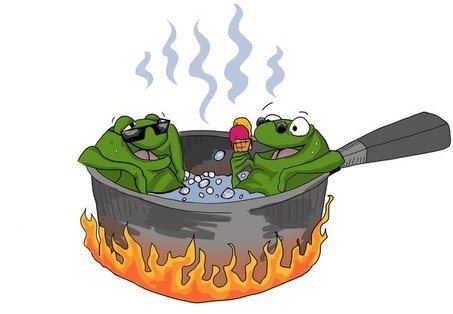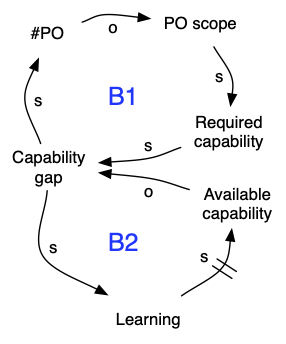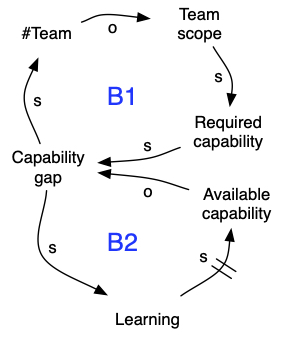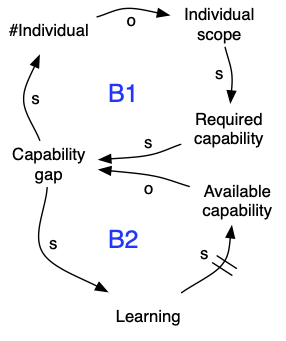(Originally published on Odd-e’s blog)

It is natural that people specialize in various things, but when they do it too much, it becomes over-specialization. Over-specialization wastes our potential. We shall try to understand why it happens, and how the adoption of LeSS avoids it.
“Eroding goals” is a system archetype consisting of two balancing loops. Think of any problem as the gap between the goal and the actual state. There are two types of solutions. One is to improve the actual state so that the gap is reduced (i.e. problem is solved), the other is to lower the goal. Over time, this evolves into “eroding goals”, and can lead to a “boiling frog” situation. This is a very simple, but powerful dynamic. Let’s see a few examples at work.
I have described this topic in the article about “team PO as anti-pattern”. Here we don’t talk about fake POs who are not responsible for the product. The real PO may still specialize in some product domain. This is often a response to the capability gap.

The B1 loop illustrates the solution of lowering the goal. By having more POs, the scope of every PO would be narrower, which requires lower capability.
The B2 loop illustrates the solution of improving the actual state. By increasing the learning, the available capability improves. However, it will take time, which makes B1 loop dominant - the goal erodes. This is what we have observed. While growing a company, each PO gets narrower and narrower scope to be responsible for. Also note that we get more and more POs in this dynamic.
Let’s look at the team. Team may specialize in some function, component or domain. They become a functional team, a component team and a specialized feature team, respectively. Specialized feature team here means that it is able to deliver end-to-end feature, but it has its own product backlog only containing features of the partial product, i.e. specializing in a product domain.

This is essentially the same dynamic as with PO specialization. The B1 loop lowers the goal by having more teams and each team responsible for the narrower scope, be it function, component or domain. The B2 loop improves the capability, but takes time. This is why we observe that teams get more and more specialized, and meanwhile we get more and more teams.
Let’s look at team members. An individual team member may also specialize in some function, component or domain too. They become specialists in the team.

This is actually a generalisation of PO specialization, and we see the same dynamic. Individuals get more and more specialized until they become single specialists. It causes creation of a dynamic (non-stable) team to match the work and ultimately feature group or project in a matrix organization. Likewise, we get more and more people.
This is something I have observed in many organizations. Over time, people specialize more and more, and the company grows bigger and bigger in size, while people’s potential is not fully realized!
Interestingly and perhaps accidentally, LeSS avoids “eroding goals”.
| What causes “Eroding goals” | What LeSS advocates |
|---|---|
| Functional team | Cross-functional team |
| Component team | Feature team |
| Specialized team (own backlog) | Generic team (shared one product backlog) |
| Single specialist in dynamic group | Generalizing specialist in stable team |
| One PO for one team | One PO for multiple teams |
Which one is better, being comfortable but not reaching the potential, or “painfully” growing and realizing one’s full potential? This gets philosophical and surely everybody has their own answer.